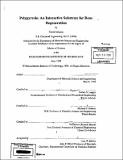| dc.contributor.advisor | Robert S. Langer. | en_US |
| dc.contributor.author | Rahman, Nahid, S.M. Massachusetts Institute of Technology. | en_US |
| dc.contributor.other | Massachusetts Institute of Technology. Dept. of Materials Science and Engineering. | en_US |
| dc.date.accessioned | 2010-01-07T20:52:23Z | |
| dc.date.available | 2010-01-07T20:52:23Z | |
| dc.date.copyright | 1998 | en_US |
| dc.date.issued | 1998 | en_US |
| dc.identifier.uri | http://hdl.handle.net/1721.1/50554 | |
| dc.description | Thesis (S.M.)--Massachusetts Institute of Technology, Dept. of Materials Science and Engineering, 1998. | en_US |
| dc.description | Includes bibliographical references (leaves 59-68). | en_US |
| dc.description.abstract | Current methods of bone repair rely on autografts (bone from a donor site) and allografts (bone from human cadaver). However, these methods are plagued with disadvantages. There is a clear and urgent need to provide alternatives for regenerating and repairing bone. Bone is known to be one of the many connective tissues in the body that are responsive to exogenous electrical stimulation. Based on this principle, this thesis explores the potential of using an electrically conducting polymer, polypyrrole, as a substrate for bone regeneration. Optically transparent thin films of polypyrrole, with a polyanionic dopant, poly(styrenesulfonate), were synthesized electrochemically and characterized by X-Ray Photoelectron Spectroscopy, UV/VIS spectroscopy, Scanning Electron Microscopy and by electrical conductivity measurements. In this study, Bone Marrow Stromal Cells (BMSC), which are the progenitor cells to bone cells (osteoblasts), were used as the in vitro model system. Their viability, proliferation and differentiation capabilities were evaluated on polypyrrole, in the absence and presence of electrical stimulation. Results indicate that polypyrrole is ideally suited as a substratum for BMSC growth and differentiation. The application of an electrical stimulus through the polypyrrole substrate was found to induce the differentiation of BMSC towards an osteogenic lineage. Thus, polypyrrole, by virtue of its conductive properties, its in vitro biocompatibility and its flexibility in altering surface characteristics, has an exciting potential as a suitable interactive substrate for bone regeneration. | en_US |
| dc.description.statementofresponsibility | by Nahid Rahman. | en_US |
| dc.format.extent | 70 leaves | en_US |
| dc.language.iso | eng | en_US |
| dc.publisher | Massachusetts Institute of Technology | en_US |
| dc.rights | M.I.T. theses are protected by
copyright. They may be viewed from this source for any purpose, but
reproduction or distribution in any format is prohibited without written
permission. See provided URL for inquiries about permission. | en_US |
| dc.rights.uri | http://dspace.mit.edu/handle/1721.1/7582 | en_US |
| dc.subject | Materials Science and Engineering. | en_US |
| dc.title | Polypyrrole : an interactive substrate for bone regeneration | en_US |
| dc.title.alternative | Interactive substrate for bone regeneration | en_US |
| dc.type | Thesis | en_US |
| dc.description.degree | S.M. | en_US |
| dc.contributor.department | Massachusetts Institute of Technology. Department of Materials Science and Engineering | |
| dc.identifier.oclc | 46240977 | en_US |
